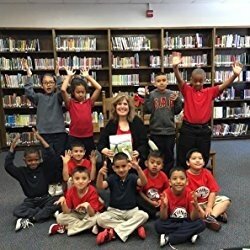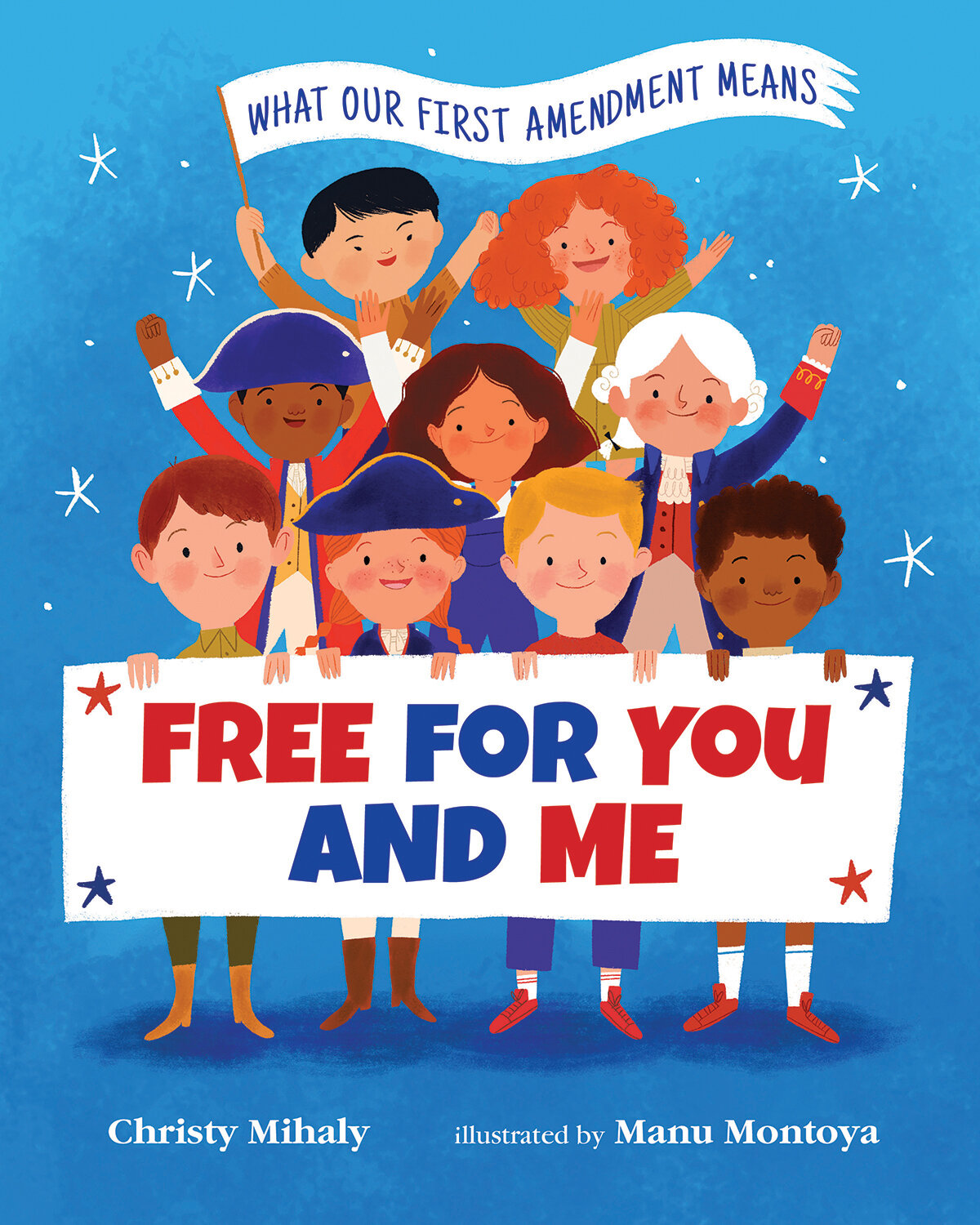What are our rights to speak our minds under the First Amendment? Who better to answer that question for kids than lawyer turned author, Christy Mihaly? Christy writes for young readers because, in her words, she believes that “our best hope for the future is raising kids who love to read.” Her picture book Free for You and Me: What Our First Amendment Means (illustrated by Manu Montoya, Albert Whitman Co.) introduces our First Amendment freedoms to young readers through poems and stories.
Christy also shared her passion for getting kids to think about the world around them in Diet for a Changing Climate: Food for Thought, a nonfiction Young Adult co-written with Sue Heavenrich (Lerner/Twenty-First Century Books, 2018) about how our diet affects the earth; and Hey, Hey, Hay! (A Tale of Bales and the Machines That Make Them (illustrated by Joe Cepeda, Holiday House, 2018), a Bank Street Best Book of the Year. She has written more than 20 children's nonfiction titles on topics from free speech to food to fashion. She lives in Vermont, where she enjoys walking her dog in the woods and playing the cello (though not simultaneously). We’re so happy she decided to visit us on THE KIDS ARE ALL WRITE (we assume not while walking her dog in the woods or playing the cello, although that would make an excellent illustration…).
Christy Mihaly
What inspired you to write Free for You and Me?
Sooo ... About four years ago, I started hearing more and more people making statements that reflected fundamental misunderstandings about the U.S. Constitution. People who should have known better called for flag-burners to be imprisoned and lose their American citizenship. Sheesh. I kept thinking about the need for Americans to appreciate the principles on which our government is founded. I wanted to help kids understand the scope of our rights and freedoms, which some adults seemed to have forgotten (or never learned). I talked with my wonderful agent, Erzsi Deak, and we joked that I should create a board book about the Constitution. Then I thought, maybe a picture book introducing the First Amendment! Not an obvious picture book topic, right? But the idea wouldn't leave me alone. Eventually, after much rethinking and many revisions, it turned into this book.
Free for You and Me by Christy Mihaly, illustrated by Manu Montoya (Albert Whitman & Company)
You have surprising details, including one about the congressman who was jailed for criticizing President John Adams. Where did you find that?
Ah, the story of Matthew Lyon! He is a Vermont hero--many Vermonters are familiar with his story. I started reading and researching about Congressman Lyon many years ago, when I first heard about him from a friend, and before I'd conceived of this book. Lyon was one of those larger-than-life characters. He came over from Ireland on his own as an indentured servant while a young boy, eventually made his way to the wilderness of Vermont where he joined Ethan Allen's Green Mountain Boys, participated in the American victory at Fort Ticonderoga in the beginning of the Revolution, made his fortune, became prominent in Vermont politics, was elected to Congress as an enthusiastic anti-Federalist, got involved in a brawl on the floor of Congress (which was widely publicized in his day), and ended up moving to the frontier of Kentucky and representing that state in Congress later in his life. In including the story of Matthew Lyon's arrest in FREE, I wanted to convey to kids the notion that the ideas behind the First Amendment, and people's interpretations of the Constitution's meaning, were evolving in the early days of our nation. I wanted to invite them to think about how amazing and wonderful it is that in this country we have the freedom to criticize our leaders without fear of this kind of retribution.
You wrote that President Thomas Jefferson affirmed freedom of speech, including the right to criticize the president. Was that a turning point in American history? Has that issue come up again as far as you know?
I think that the question of the proper scope of freedom of speech is constantly with us. There are aspects of this right that people today find difficult to understand. For example: Is hate speech protected under the First Amendment? In fact, our courts have repeatedly held that the First Amendment protects hate speech. Is that good or bad? People still debate these issues. At various points in our history, especially during wars, free speech has been restricted. During the Civil War, Abraham Lincoln censored telegraph dispatches and people were arrested for supporting the Confederate cause, even singing songs of the Confederacy. The government has repressed speech repeatedly in the name of national security during wars and national crises. Recently some have argued that Americans who criticize government leaders are "unpatriotic" or "traitors." To the contrary, true patriotism is not blind loyalty, but the willingness to engage in an open and public discussion about how the government can best live up to our democratic ideals.
Free for You and Me by Christy Mihaly, illustrated by Manu Montoya (Albert Whitman & Company)
What surprised you the most as you did your research?
One of the most striking things is how the Constitution is a living, evolving document. The ideas that the founders wrote down were revolutionary at the time, and we as a nation continue to grapple with their significance and interpretation.
How did you decide on your structure — the rhyming text along with other information in thought bubbles?
It took a while to figure this out. The idea of poems came to me early, both because I enjoy writing in rhyme, and because poetry can cut to the heart of complex issues in just a few words. There are five freedoms named in the First Amendment—maybe a poem about each? (The five are: freedom of religion, of speech, and of the press, and the rights to assembly and to petition the government for redress of grievances.) Slowly the poems evolved. I liked them! But five poems didn't make a book. I felt I needed to explain the historical background of the First Amendment, and I wanted to elucidate how kids could use these rights. So I added historical vignettes and then a contemporary story. The manuscript received some editor interest, but it wasn't quite hanging together. I revised. (I tried two or three modern stories before settling on the one that's in the book.) My book eventually found its way to just the right editor for this work, Wendy McClure at Albert Whitman. Wendy and I worked together to add some poems to my original five, and then to create and refine the speech bubbles in the historical vignettes and the modern story, and revise and complete the back matter. Our creative process continued during Manu Montoya's development of her lively and fun illustrations. We wanted this book to be engaging and to reflect America's diversity, and I'm so pleased with how it all turned out.
Free for You and Me by Christy Mihaly, illustrated by Manu Montoya (Albert Whitman & Company)
How long did the book take from idea to complete manuscript? What were some of the changes you made along the way?
I began writing in early 2017 with some rough poems. The complete manuscript was finished in mid-2019. That's not long, as picture books go. I made changes in everything, from wordsmithing the poetry to deleting whole passages to changing the story line of the contemporary tale. The bulk of revision involved cutting needless words, but we also added explanation where we thought it would be useful for kids and their adults.
How does being a lawyer influence your writing and how did it influence this book in particular?
Generally, in practicing law, much of my work was to research a topic deeply, analyze it, get to the truth of the issue, and then explain it in clear and easily understandable terms to clients--and judges--who were not experts in the field. Bonus points for making it engaging! That practice has been useful training for writing children's nonfiction--where the task is take complex ideas, boil them down to their essence, and write them in a clear and engaging way.
With respect to legal topics in particular, my familiarity with constitutional concepts made me sensitive to certain political conversations in the United States. Because I had studied and pondered the importance of First Amendment rights, I wanted to share those important ideas with kids. That's how Free for You and Me came to be. Until recently, I hadn't used my substantive knowledge of the law in the books I wrote. But in the last couple of years, I've published two nonfiction series (12 books!) about government and civics. (Rourke Educational Media: "Shaping the Debate," and "Governing the United States.") I've really enjoyed building on my legal background with books such as Ask the Attorney General, and Defining and Discussing Freedom of the Press, as well as Free for You and Me. I'm now considering more picture books about our government and legal system ... kid-friendly, of course.
What do you hope kids will learn from your book?
I hope they'll begin to understand--and to love--the privileges that our Constitution gives people in this country. And I hope they'll start to appreciate the importance of protecting our freedoms, and to see that this requires vigilance and dedication and courage--and exercising those rights.
Hey, Hey, Hay! by Christy Mihaly, illustrated by Joe Cepeda (Holiday House)
Is there anything you would like to add?
I think I've stood on this soapbox long enough for the moment. Maybe just a shout-out to all the incredible teachers, and parents, and families out there, all doing their best as we learn together. Oh, and I've been working with the amazing people at Curious City to put together an educators' guide and a video. You can download the guide at my website -- FREE. Thank you, Nancy, for the chance to share my book. And stay well, everyone!
Diet for a Changing Climate, Food for Thought by Christy Mihaly and Sue Heavenrich (Lerner Books/Twenty-First Century Books)
Christy Mihaly looks forward to connecting with you on social media!
On her website: www.christymihaly.com
On Twitter: @CMwriter4kids
On Instagram: @christymihaly
On Facebook: www.facebook.com/christymihaly/
On the GROG blog: https://groggorg.blogspot.com/







